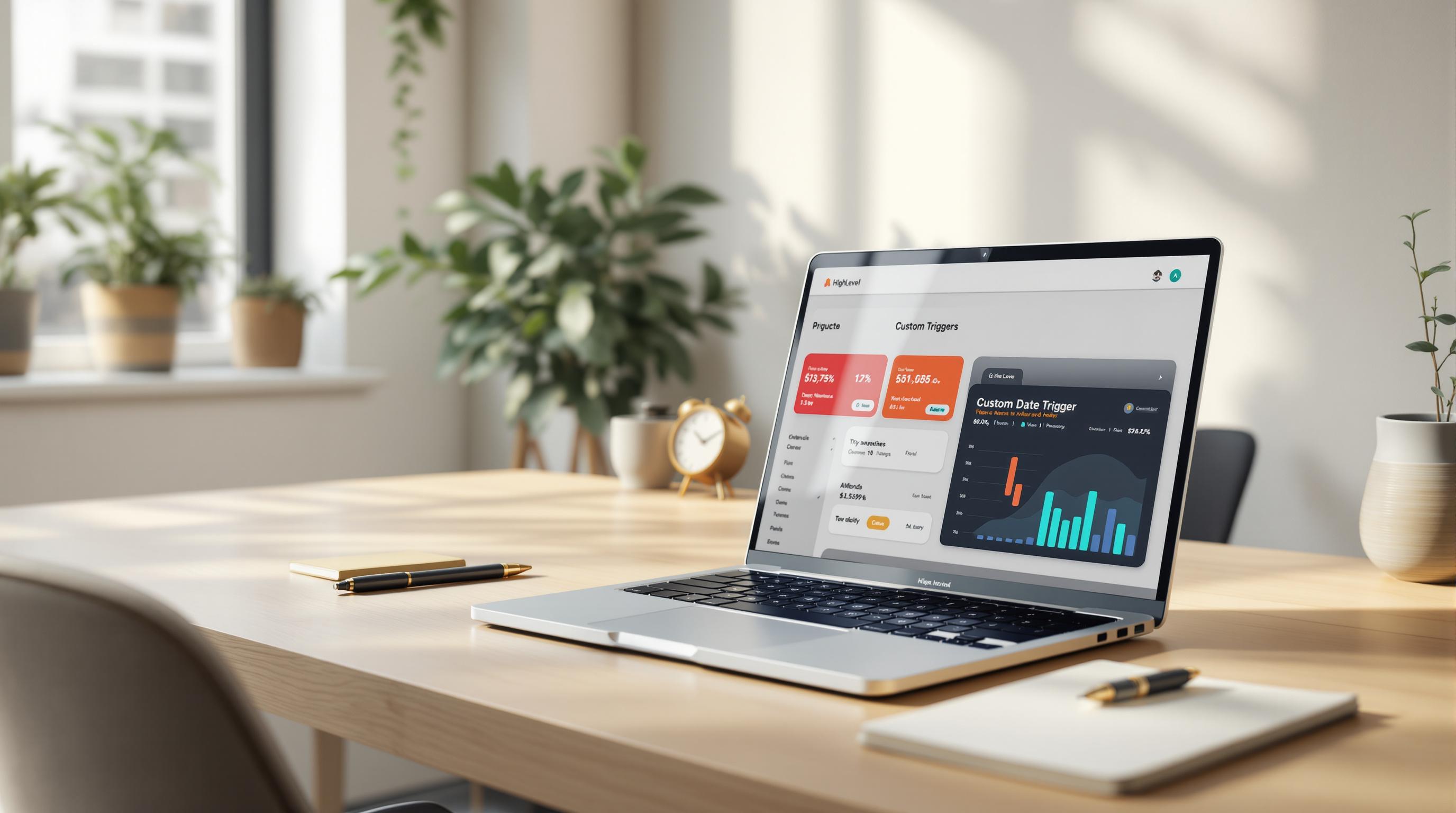Agencies juggle multiple tasks daily, from managing leads to client communication, often leading to inefficiencies. CRM automation can help streamline processes, improve accuracy, and save time. Here’s a quick look at how to optimize your agency's workflows using HighLevel's tools:
- Automate Lead Tracking: Use smart contact management and lead scoring to organize and qualify leads faster.
- Simplify Client Onboarding: Automate workflows for forms, document collection, and task assignments to save hours per client.
- Use Smart Lists: Automatically segment contacts based on behavior, status, or location for targeted campaigns.
- Automate Follow-Ups: Set triggers for timely, personalized communication like meeting reminders or milestone updates.
- Connect Multiple Channels: Manage email, SMS, WhatsApp, calls, and social media from one dashboard to boost engagement.
- Test Campaigns with Workflow Splits: Experiment with variables like email subject lines or timing to optimize results.
- Add Dynamic Email Elements: Personalize emails with names, locations, and behavior-based content to increase engagement.
- Use Payment Links: Automate billing and reminders to speed up transactions and reduce admin work.
- Automate Review Requests: Collect feedback at key moments to improve client satisfaction and manage your reputation.
- Leverage White-Label Features: Customize portals, reports, and communication to strengthen your agency's branding.
Related video from YouTube
1. Automate Lead Tracking to Stay Organized
Using HighLevel CRM tools to automate lead tracking helps cut down on manual tasks and ensures no potential leads slip through the cracks.
Smart Contact Management brings all your lead data from various channels into one place. This reduces mistakes and keeps your information accurate [2].
Lead Scoring Automation makes qualifying leads easier by ranking them based on their actions. It flags prospects ready for sales and automatically triggers follow-ups [4].
Agencies using HighLevel's lead tracking tools have reported impressive results:
| Metric | Average Improvement |
|---|---|
| Lead Response Time | 65% faster |
| Data Entry Hours | 25% reduction |
| Lead Conversion Rate | 30% increase |
| Missed Follow-ups | 80% decrease |
To get the most out of lead tracking automation, focus on these areas:
- Workflow and Status Updates: Set up workflows to handle tasks like creating contact records, assigning scores, and sending welcome emails. Real-time updates help you monitor where leads are in the pipeline and ensure timely, personalized communication [1] [4].
- Cross-Channel Tracking: Monitor leads across platforms like websites, emails, and social media to see which channels work best for generating leads [2].
With automated lead tracking in place, agencies can shift their attention to optimizing the next step: client onboarding.
2. Simplify Client Onboarding with Automation
Automating client onboarding turns a once time-intensive process into a smooth and efficient system. HighLevel's CRM tools make it easy for agencies to set up workflows that save time and ensure consistency without adding extra manual tasks.
Smart Workflow Implementation ensures timely communication by automating responses based on client actions, such as filling out forms or scheduling calls. This approach eliminates the need for constant manual follow-ups and can save 8–10 hours per client during onboarding [2].
Personalized Document Management streamlines paperwork by combining automated document collection with tailored communication. Use templates and questionnaires that adapt to client responses, making it easy to handle contracts and other essential documents efficiently [3] [4].
Team and Progress Coordination keeps everyone on the same page with automated task assignments and progress-based triggers. Smart lists track each client's status, ensuring every step of the onboarding process is handled consistently and without delays [2].
Data Integration connects HighLevel with other key tools, removing the need for repetitive data entry and allowing information to flow seamlessly between platforms. This reduces errors and speeds up the entire process [1].
Track metrics like completion rates and client satisfaction to fine-tune your workflows over time. Regular updates ensure your onboarding process stays efficient and meets quality expectations [4].
Once onboarding is running smoothly, agencies can focus on strengthening client relationships with automated follow-ups.
3. Use Smart Lists to Manage Contacts
HighLevel's smart lists automatically organize contacts based on their behaviors and attributes, cutting down on manual work and helping you target the right audience. You can sort contacts using criteria like engagement levels, email opens, purchase history, location, job titles, or custom tags.
These lists use behavior-based triggers to add or remove contacts automatically, keeping your campaigns relevant without constant manual updates [1].
| Smart List Type | Example Use Case | Time-Saving Benefit |
|---|---|---|
| Engagement-Based | Separate active and inactive clients | Spot re-engagement opportunities |
| Purchase History | Group by service type | Run targeted upsell campaigns |
| Lead Status | Track sales funnel stages | Automate follow-up sequences |
| Geographic | Organize by location | Focus on regional campaigns |
Smart lists also work with workflows, enabling automated actions like scheduling sales calls for your most engaged prospects [2].
On top of that, HighLevel ensures your data stays clean by automatically updating contact details and removing duplicates. Performance metrics, such as list growth and engagement rates, provide insights to fine-tune your strategy [4].
4. Automate Follow-Ups to Improve Communication
Automating follow-ups allows agencies to keep client communication consistent without the hassle of manual tracking. Tools like HighLevel's drag-and-drop workflow builder make it easy to set up follow-up sequences that feel personal, even at scale [2].
These workflows are triggered by specific client actions, ensuring follow-ups are timely and relevant. By using client data and engagement history, messages can be tailored to fit the situation [2][4].
| Trigger Event | Automated Follow-up |
|---|---|
| Meeting Scheduled | Send meeting details and agenda |
| Proposal Sent | Follow up on proposals |
| Service Milestone | Share progress updates |
| Missed Call | Send availability options |
Here’s how to make the most of automated follow-ups:
- Set Clear Triggers and Data Rules: Define the exact conditions that will activate a follow-up. HighLevel’s automated data updates ensure workflows stay accurate and effective [1].
- Analyze and Adjust: Use HighLevel’s analytics to track how well your sequences are performing. Fine-tune your strategies based on engagement metrics [4].
- Experiment with Variations: Test different follow-up methods by splitting workflows. This helps identify what works best based on actual results [2].
By blending automation with personalization, agencies can build follow-up systems that not only save time but also strengthen client relationships.
Once your follow-ups are automated, you can focus on broadening your outreach by incorporating multiple communication channels.
5. Connect Multiple Channels for Better Reach
Automating follow-ups is just the start. To truly engage clients, it’s important to use multiple communication channels. HighLevel simplifies this by bringing email, SMS, WhatsApp, voice calls, and social media into one dashboard. This makes it easier to maintain consistent messaging while connecting with clients on the platforms they use most [2].
| Channel | Best Use Case |
|---|---|
| Sending proposals and reports | |
| SMS | Quick updates and reminders |
| Voice | Handling complex discussions |
| Social Media | Building brand engagement |
| Communicating internationally |
Here’s how to make multi-channel communication work effectively:
- Automate Responses by Channel: Set up workflows that deliver clear, consistent messages while adapting to the tone and style of each platform [4].
- Track Client Interactions: Monitor how clients engage across different channels to figure out what works best for various communication needs [4].
- Choose the Right Channel: Use client data to automatically pick the most effective communication method for each interaction, boosting response rates [2].
sbb-itb-f031672
6. Use Workflow Splits to Test Campaigns
Workflow splits let agencies test different campaign elements side by side, acting as structured experiments to refine strategies using real data. By automating this process, agencies save time and ensure their decisions are backed by measurable outcomes.
| Test Element | Common Variables to Test | Why It Matters |
|---|---|---|
| Email Subject Lines | Personalization vs Generic | Drives open rates |
| Message Content | Long-form vs Brief | Influences engagement |
| Call-to-Action | Button vs Text Link | Impacts conversion rates |
| Timing | Morning vs Evening | Affects response rates |
| Communication Style | Formal vs Casual | Shapes client interactions |
To get started, pick one element to test. For example, if you’re focusing on email subject lines, make sure everything else in the workflow stays the same across both paths.
HighLevel’s visual workflow builder makes this process straightforward. You can create two parallel paths, set specific conditions for each, and let the platform track key metrics like open rates, click-through rates, and conversions automatically [4].
Here’s an example: A marketing agency tested two onboarding approaches - Path A used email-only communication, while Path B combined emails with calls. After 30 days, Path B showed 14% higher engagement and reduced onboarding time by three days [1].
To get the most out of workflow splits:
- Start Small: Focus on one variable at a time for clear insights.
- Define Success Metrics: Decide what success looks like before running the test.
- Allow Enough Time: Run tests long enough to gather reliable data, and document results for future campaigns.
Once you’ve fine-tuned your campaigns, consider adding dynamic elements to further boost client engagement.
7. Add Dynamic Elements to Emails
Dynamic elements help tailor emails to individual recipients while streamlining the process through automation. HighLevel's CRM tools make it easy to customize emails automatically using client data, behaviors, and preferences.
| Dynamic Element | Purpose | Impact on Engagement |
|---|---|---|
| Personalized Greetings | Use the recipient's name | Boosts open rates by 14% [5] |
| Location-Based Content | Provide relevant local offers/info | Improves click-through rates |
| Behavioral Triggers | React to specific client actions | Increases conversion rates by 10% [5] |
| Time-Sensitive Content | Add countdowns or deadlines | Encourages quick action |
| Custom Product Recommendations | Suggest services based on history | Makes emails more relevant |
To make these elements work effectively, focus on three things: clean CRM data, a structured personalization approach, and thorough testing. Keep contact data accurate by updating it regularly and removing duplicates. Test emails on various platforms to ensure dynamic features function properly, and always include fallback options to avoid errors.
With HighLevel's automation tools, you can set up advanced email workflows triggered by client actions. For instance, if a client visits a specific service page, you could send an email that includes:
- Their name and company
- Suggestions for related services
- Case studies tied to their location
- A tailored call-to-action
According to industry research, 62% of marketers say personalization is essential for email marketing success [4]. By automating dynamic features, agencies can send customized emails that boost engagement without adding extra work.
8. Use Payment Links for Faster Transactions
Payment links simplify how agencies manage client payments by automating the billing process through HighLevel's CRM platform. Instead of manually creating invoices, you can send payment requests directly via email or SMS.
Here’s a quick look at how payment links can make your financial operations more efficient:
| Payment Feature | Time-Saving Benefit | Business Impact |
|---|---|---|
| Automated Billing | No need for manual invoice creation | Saves hours of admin work each week |
| Multi-Channel Delivery | Sends requests via email or SMS | Speeds up payment collection |
| Payment Gateway Integration | Automatically processes transactions | Cuts down reconciliation time |
| Automated Reminders | Follows up on unpaid invoices | Reduces late payments |
| Payment Status Tracking | Tracks and updates payment status | Simplifies financial reporting |
To make the most of payment links, integrate them into your workflows. For example, when a project milestone is reached, HighLevel can automatically:
- Generate a payment link with the correct amount.
- Deliver it to the client through their preferred channel (email or SMS).
- Monitor the payment status and send reminders if necessary.
- Update the client’s record once the payment is processed.
Security First: HighLevel uses SSL encryption and is PCI compliant, ensuring payment data stays secure.
Pro Tip: For recurring services, set up payment link templates to save time and maintain consistent billing.
When a client completes a payment, you can trigger automated workflows to:
- Send a receipt confirmation.
- Update the project status.
- Schedule the next deliverables.
- Notify your team.
Streamlining payments gives you more time to focus on other areas, like automating client feedback to strengthen your reputation management.
9. Automate Review Requests to Manage Reputation
Gathering consistent client feedback is key to building a strong online reputation. HighLevel simplifies this process with automation tools that still feel personal.
Here’s how automated review requests can help manage your reputation effectively:
| Trigger | Timing | Purpose |
|---|---|---|
| Project Completion | 7 days after | Collect feedback while the experience is fresh |
| Service Milestone | 24 hours after | Get input on specific deliverables |
| Quarterly Check-in | Every 3 months | Track ongoing client satisfaction |
| Post-Support Resolution | 48 hours after | Evaluate the effectiveness of support teams |
Timing Matters: Set delays between triggers to avoid overwhelming clients, ensuring better-quality responses.
Tips for Effective Review Requests
- Personalize Your Messages: Reference specific projects, milestones, or services. Mention client names and details to make messages more engaging and relevant.
- Use Multiple Channels: Automate requests via email or SMS and follow up if there’s no response. Track engagement to find the best timing and platform for each client.
- Manage Responses Efficiently: Set up workflows to notify your team about new reviews, thank clients for positive ones, and flag negative feedback for quick resolution.
Pro Tip: Use workflow splits to tailor follow-ups based on review scores, helping you address issues faster.
HighLevel’s analytics dashboard lets you monitor response rates and ratings, helping you fine-tune your timing and messaging for better results. With automated review management, you can focus on growing your brand while leveraging HighLevel’s white-label tools.
10. Use White-Label Features to Build Your Brand
Boost your agency's professional presence by using HighLevel's white-label tools. These features let you offer a fully branded experience that strengthens client relationships and saves you time.
Key White-Label Features
| Feature | How It Helps Your Business |
|---|---|
| Client Portal | A branded interface builds trust with your clients. |
| Report Templates | Polished, branded reports enhance your credibility. |
| Email Communications | Consistent messaging reinforces your agency's identity. |
| Support Materials | Branded guides and documents improve client perception. |
Keeping Your Brand Consistent
Align every client-facing tool with your brand by customizing colors, fonts, logos, and even domains. This approach ensures your agency looks professional and trustworthy at every interaction.
Tips for Smart Branding
Examine tools like dashboards, reports, and emails for branding opportunities. Automate the creation of branded materials to save time and focus on your clients. Templates are a great way to maintain consistency and streamline communications.
Tracking Success
Monitor metrics like client retention, feedback, and portal usage to see how your branding efforts are performing. Regularly updating these branded elements keeps your agency looking polished and makes managing clients easier.
Conclusion
Using CRM automation effectively can change the way agencies handle client relationships and manage internal tasks. HighLevel's platform offers tools that can improve both efficiency and client satisfaction.
Here's a quick look at how automation can make a difference:
| Area | Benefits |
|---|---|
| Lead Management | Easier qualification and tracking |
| Client Communication | Better engagement and retention |
| Task Automation | More time for strategic work |
| Reporting | Smarter, data-based decisions |
Automation not only streamlines operations but also helps agencies grow without sacrificing quality. Research shows automated processes can cut administrative tasks by up to 30%, freeing up teams to focus on more valuable work [1].
Start by automating your most time-consuming tasks, like onboarding new clients or managing follow-ups. Track metrics like conversion rates, client retention, and time saved to fine-tune your approach over time [4]. The aim is to build a system that grows alongside your agency.
Ready to get started? HighLevel's suite of automation tools is a great place to begin. Focus on one impactful area first, measure your results, and expand from there. With the right approach, your agency can grow efficiently while delivering outstanding client experiences.



